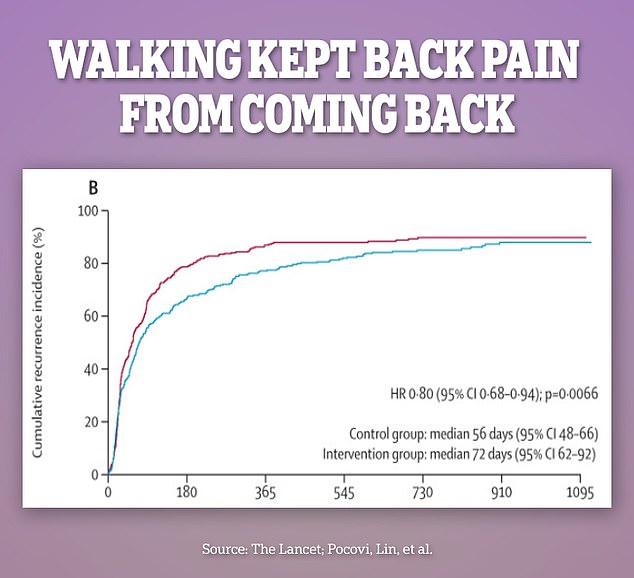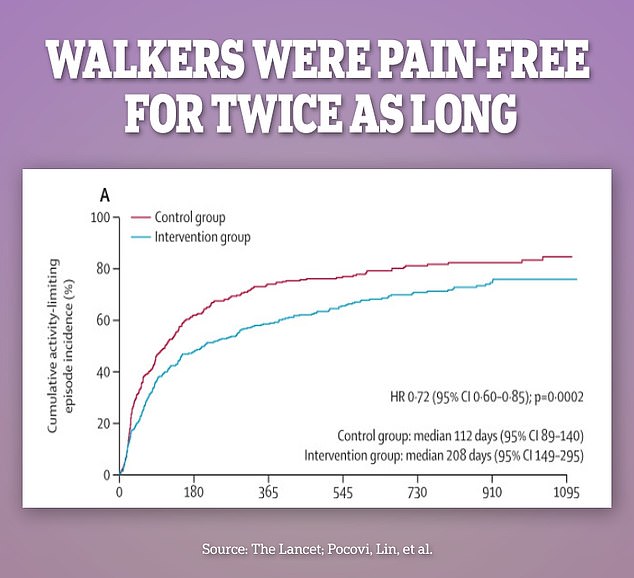Anyone who has low back pain knows that it can be a debilitating condition that limits the ability of nearly 65 million Americans to move and participate in daily life.
But new research suggests that simply getting up and walking through pain is a very effective way to reduce pain and return to a normal life.
Australian researchers tested two groups of people: one group received no treatment and the other was asked to walk for 30 minutes five times a week.
After following the participants for one to three years, they found that the group that walked regularly was pain-free for almost twice as long as those who didn’t: 208 days versus 112.
The study, which was conducted between September 2019 and June 2022, is the first to advocate the need for walking to treat aches and pains.
Some 16 million American adults experience chronic back pain thanks in part to high rates of inactivity and obesity and an ever-expanding senior population. While tens of millions more experience some form of discomfort.
This translates to lost time at work, expensive trips to physical therapists, and fees for exercise classes that require specialized equipment.
The walking group was pain-free for 208 days versus 112 days in the control group.

Walking Prevented Back Pain from Reoccurring
But walking is a free intervention, which makes it exceptionally attractive and accessible.
701 people participated in the study, 80 percent of whom were women. All of them had recently recovered from an attack of severe low back pain.
One group was assigned three months of zero intervention. But the second group was given six sessions of educational classes with a physical therapist and asked to start walking 30 minutes a day for five days a week for three months.
Dr. Mark Hancock. A physiotherapist from Macquarie University, saying: “The intervention group had fewer cases of activity-limiting pain compared to the control group, and a longer average period before they suffered a recurrence, with a median of 208 days compared to 112 days.”
Participants wore a device that recorded their walking or jogging speed and step count, and recorded it in a daily walking diary.
The walking group also missed fewer days of work and cut doctor visits related to their pain in half. Walking also improved people’s sleep and mood.

Walking is free and can be easily expanded. Unlike other interventions like exercise classes, it requires no specialized equipment and has countless heart health benefits.
Dr Hancock said: “We don’t know exactly why walking is so good for preventing back pain, but it is likely to include a combination of gentle oscillatory movements, loading and strengthening of spinal structures and muscles, relaxation and relief. of stress, and release of endorphins that make us feel good.’
It’s no secret that walking has countless cardiovascular and other health benefits, but not enough Americans do it.
According to the CDC, fewer than 47 percent of American adults met federal physical activity guidelines, which recommend getting 150 minutes of moderate-intensity exercise, such as brisk walking, each week.
A separate study published in 2012 found less than a quarter of Americans They reported walking for more than 10 minutes at a time in a typical week.
Walking aimlessly may seem like a boring and meaningless activity, but it improves blood circulation to the muscles, helps with weight control, improves metabolism, and releases mood-boosting endorphins.
While it is impossible to determine from the study whether walking was more effective than the educational sessions, the researchers believe that “the two components complement each other, with education helping to overcome avoidance and fear of movement, while training program and the walking program resulted in healthy behavior. change.’
Humans evolved from beings with a horizontal spine and, over millions of years, have had to adapt to support most of the body’s weight and all the pressures of movement throughout life with normal wear and tear, injuries, sedentary lifestyle and obesity.
Previous studies have shown the benefits of exercise in relieving back pain, the leading cause of disability worldwide, but they have always involved group exercise classes that required close supervision and expensive equipment.
The researchers concluded: “This intervention should be relatively easy to scale up and could substantially reduce the burden due to low back pain, including reducing costs associated with care.”
His research was published in the Lancet.


